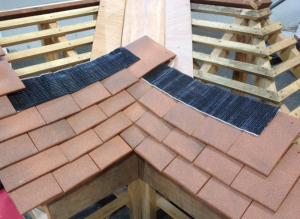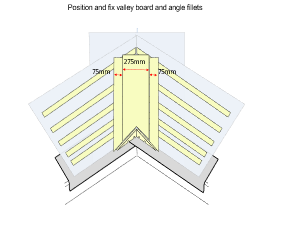Swept and laced valleys- groundwork
To achieve the functional and visual appearance of a swept or laced valley using plain tiles, it is important that the necessary groundwork beneath the tiles is constructed correctly.
A minimum 600mm wide strip of underlay should be laid down the centre of the entire valley length and covered by the main underlay lapped and cut into the valley intersection.
To ensure the cut tiles form a neat curve or angle around the valley, a minimum 275mm wide x 19mm thick timber board should be supported and fixed to each rafter down the length of the valley rafter above the underlay. The width of the board can vary slightly to accommodate the rafter pitch. Two additional ‘feather edged’ boards of minimum 75mm wide x 19mm -6.5mm should be nailed to each side of the centre board, with the thickest edge facing the centre line, and positioned to halve the angle between the main rafters and the centre board. The resultant groundwork should enable a continuous faceted surface onto which the cut tiles can be fixed securely as they are laid.
At the eaves, 75mm minimum height tapered timber fillets should be used to raise the eaves course of tiles. The height of the fillet depends on the main valley board position in relation to the subtended angle of the valley.
The tiling battens contiguous to each side of the feather edge boards should be cut to finish flush with the top surface and align horizontally with the battens on the adjacent roof slopes.
Code 3 lead or bituminous sheet soakers may be required to be laid beneath each course of tiles towards the valley to maintain the weathertightness of the reduced head and side laps.

Laced valley construction showing soakers laid nearest to the valley.
(Similar groundwork applies to swept valley construction). Underlay omitted for clarity in photo.
